
In this chapter, the largest in the book, we cover all types of tactical “motifs” such as pins, skewers, removal of the guard, etc. In each section we will define the motif, give examples of it, and then provide some problems for you to solve. The answers are at the end of each section.
Most of the problems are taken from my student’s games. This gave me the opportunity to see which tactics were overlooked the most often, and thus emphasize these in this book. The three most overlooked tactics were double attacks (including knight and pawn forks), removal of the guard, and pins, in that order. Therefore, there are more problems with these three common motifs.
This section deals with positions where one side can win material by trapping a piece, usually by attacking it with a piece of lesser value. Let’s consider some simple examples that commonly occur among beginners. These are good patterns to learn!
White to play and win

In this first example, White can trap the h8-rook with 1.Bxg7. This wins the exchange as long as Black is clever enough to trap the bishop on h8 with ...f6 and then eventually capture it. Otherwise, White would win a whole rook!
White to play

This is a recurring pattern – the knight cannot take the rook’s pawn. If 1.Nxh7?, then 1...f6 traps the knight and the black king can soon capture it. Similarly, the bishop also has problems capturing a rook’s pawn.
White to play

The three most overlooked tactics are double attacks, removal of the guard, and pins.
If 1.Bxh7?, then 1...g6 traps the bishop – so one has to be careful when considering the capture of a rook pawn with either knights or bishops!
Black to play
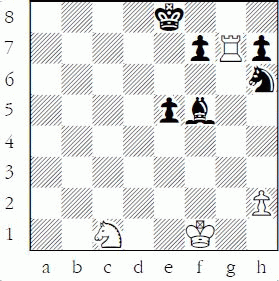
Rooks are more easily trapped after capturing the g-pawn. White has just played 1.Rxg7, but after 1...Bg6 2.h4 Kf8 3.h5 or 3.Rxg6 hxg6 3...Kxg7, Black wins material.
Black to play
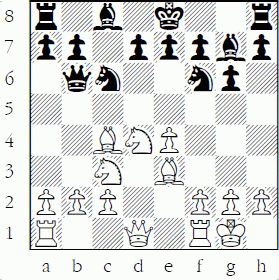
1...Qxb2?! A dubious capture. 2.N3b5 Threatening to win the rook with 3.Nc7+. 2...O-O This bring us to the following position:
White to play

Now White can trap the queen with 3.Rb1.
Pawns can easily trap bishops, even in the early stages of a game: 1.e4 g6 2.d4 Bg7 3.Nf3 d6 4.Nc3 Bg4 5.h3 Bh5?:
White to play

6.g4 traps the bishop. Notice how Black’s fianchettoed bishop on g7 and his attempt to keep the pin on the white knight on f3 are uncoordinated maneuvers, because the pawn on g6 interferes with the bishop’s mobility when it reaches h5. So if you fianchetto and then pin a knight on the same side, you usually must be willing to capture the knight if challenged.
It is also possible to trap your bishop inside your own pawn chain thereby rendering it useless. That is called a bad bishop and it is not considered a tactic (because the bishop is not lost, but it has lost most of its power). Instead it is a positional concept, and so it lies outside the scope of this book. But beware, because no matter how your pieces get trapped, it is still very bad!
There is an old saying: “Never take the b-pawn with the queen.” This is not always true, but it’s a good warning to always be careful!
2-1 White to play and win

2-2 White to play and win

2-3 Black to play and win

2-4 Black to play and win

2-5 White to play and win

2-6 Black to play and win

2-7 White to play and win

2-8 Black to play and win

2-9 Black to play and win
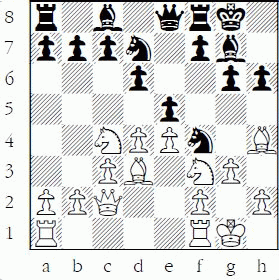
2-10 White to play and win

2-11 White to play and win

2-12 White to play and win

2-13 White to play and win

2-14 White to play and win

2-15 Black to play and win

2-16 White to play and win
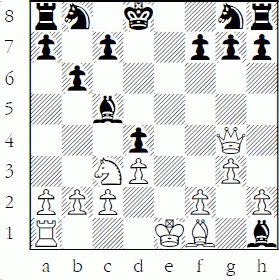
2-17 Black to play and win

2-18 Black to play and win

2-19 White to play and win

2-20 Black to play and win

2-21 White to play and win

2-22 White to play and win

2-23 White to play and win

2-24 White to play and win

2-25 White to play and win

2-26 Black to play and win

2-27 Black to play and win

2-28 White to play and win

2-29 White to play and win

2-30 Black to play and win

2-31 White to play and win

The principal concepts of what you must do when you are winning easily are:
1. Think defense first, but don’t play passively or defensively!
2. Keep it simple: complications help the one who is losing.
3. Trade pieces, not necessarily pawns: attrition is a great way to increase your relative advantage.
4. Make sure all your pieces are in the game: you are on the power play.
5. Don’t worry about the little things, e.g., if you can trade queens, don’t worry about messing up your pawn structure.
6. Play carefully, but avoid time trouble: finding the best move is no longer necessary – most good ones will do.
7. Don’t get overconfident.
2-1: 1.g4 traps the queen.
2-2: 1.Bxg7 traps the rook.
2-3: 1...g5 traps the knight.
2-4: 1...b5 4.Bb3 c4 traps the bishop.
2-5: 1.Qf3 Nc6 2.Qxc6+ Bd7 3.Qe4 wins a piece because of the trapped rook.
2-6: 1...Nxd4 2.Qxd4 c5 3.Qe3 c4 traps the bishop, a simplified “Noah’s Ark” trap.
2-7: 1.Nxc6 bxc6 2.Bb6 traps the queen.
2-8: 1...Rh6 traps the queen.
2-9: 1...Nxd3 2.Qxd3 g5 wins a piece for two pawns, although White still has chances.
2-10: 1.Qb5 traps the knight.
2-11: 1.Bd2 traps the queen.
2-12: 1.g4 traps the knight.
2-13: 1.d7 traps the bishop. And 1...Rd8 (1...Qxc3+ 2.Qd2) 2.dxc8Q still wins a piece because the rook is pinned.
2-14: 1.Nc7 Rb8 2.Bxa7 traps the rook.
2-15: 1...b6 traps the bishop.
2-16: 1.Qxg7 dxc3 2.Qxh8 wins the trapped rook and the g8-knight is lost as well.
2-17: 1...Be6 traps the rook, followed by 2...Kf8 winning the exchange.
2-18: 1...Kg7 traps the rook.
2-19: 1.g4 traps the knight.
2-20: 1...h5 wins as 2.Nf2?? Qxg2#. So the knight is trapped.
2-21: 1.Bg5 traps the queen.
2-22: 1.Rhe1 traps the queen. If 1...Nf8 2.Rxe2 Rxd4 3.Nxd4 wins a rook.
2-23: 1.Qe2 traps the knight.
2-24: 1.Ra1 traps the queen.
2-25: 1.h6 traps the knight. 1...Ng6 2.Qe3 does not change anything.
2-26: 1...Nc5 traps the rook and wins the exchange.
2-27: 1...b5 2.Bb3 a4 traps the bishop.
2-28: 1.Be4 traps the rook. After 1...b3 2.Bxc2 bxc2 3.Rc1, Black can resign.
2-29: 1.Bg5 traps the queen. If 1...Bh6 then White wins a piece with either 2.Bxh6 or, even better, trades queens when ahead with 2.Bxh4 Bxd2+ 3.Rxd2.
2-30: 1...exd4 e.g. 2.Nxd4? White is in trouble even if he does not allow the “Noah’s Ark” pattern, since he cannot recapture safely. 2...c5 3.Nf3 c4 traps the bishop.
2-31: 1.R1e6 traps the queen.
You get better when you learn something new or when you identify a mistake and no longer repeat it – not when you win a bunch of games.
A pin is a situation where a bishop, rook, or queen attacks a piece that the opponent cannot move without losing a piece of greater value behind the attacked piece along the same line.
An absolute pin is when the opponent’s king is behind the attacked piece. Then the pinned piece cannot move because the king would be in check. A relative pin is when the piece behind the attacked one is not a king, in which case the attacked piece may still move (and will if it is advantageous!).
In our first example, the black bishop is in an absolute pin; it cannot move and can be safely captured by the rook on the next move.
Black to play

An absolute pin cannot legally be broken by moving the attacked piece, since that would expose the king to attack, so play might continue 1...Kf7 2.Rxe4
In the following example, the piece behind the knight is the queen, so it is a relative pin. White can win the knight by attacking it with something of lesser value or attacking it more times than it can be defended.
White to play

Here 1.e5 will win the knight for the pawn.
Next a similar relative pin fails because the black piece can do greater damage upon its move:
White to play

1.e5?? Trying to take advantage of both the pin and a fork, but 1...Ng4#.
An absolute pin is when the opponent’s king is behind the attacked piece. The pinned piece then cannot move because the king would be in check. A relative pin is when the piece behind the attacked one is not a king.
After the sequence 1.e4 e5 2.Nf3 Nc6 3.Bb5 a6 4.Bxc6 dxc6 5.Nxe5 Qd4 6.Nf3, beginners often think they can save their queen by pinning the enemy knight to the white queen...

But after 6...Bg4?? 7.Nxd4! Bxd1 8.Kxd1, White wins a bishop. This example combines the motif of pin with counting.
Most motifs are harder to spot when there are more pieces on the board. For example, after 1.e4 e5 2.Nf3 Nf6 3.Nxe5 d6 4.Nf3 Nxe4 5.Bb5+ Nc6 6.0–0 h6, White may get distracted by the absolute pin on the c6-knight, but it is the potential absolute pin on the e-file that wins (D):
7.Re1! f5 8.d3 will win the knight in this very common pattern.

However, if we isolate the relevant pieces, then the problem becomes much easier.
White to play and win
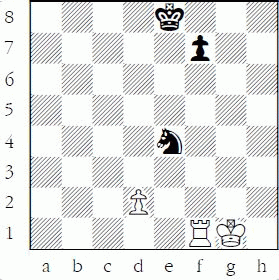
Again, 1.Re1 f5 2.d3 will win the knight, but here you can’t miss it!
In the following example, the pinned piece can be guarded on the next move, but that will still leave the defending side in the pin and subject to further attack. (D)
1.Bc3 Kf6 2.f4 will win the pinned knight.
White to play and win

If we move the king one square farther away on the diagonal, then the attack by the pawn is unnecessary.
White to play and win

1.Bc3 Kg7 2.Bxe5+ and White wins.
After the sequence 1.e4 e5 2.Nf3 Nc6 3.Bb5 d6 4.d4 a5??, White wins by attacking the absolutely pinned knight.
White to play and win

5.d5 wins the piece.
But after the much more common sequence 1.e4 e5 2.Nf3 Nc6 3.Bb5 d6 4.d4 Nf6, the attack with the pawn push fails to a defense that is worth remembering.
White to play

5.d5 a6! 6.Ba4 If 6.dxc6 axb5 7.cxb7 Bxb7 or 6.Bxc6 bxc6 7.dxc6 Nxe4, Black is OK. 6...b5 and Black does not lose the knight!
In the Queen’s Gambit Accepted, there is a well-known idea where Black is unable to take the c-pawn and hold it.
One reason is that the a-pawn doesn’t protect the b5-pawn after 1.d4 d5 2.c4 dxc4 3.Nf3 Nf6 4.e3 b5?! 5.a4 a6?:
White to play and win back his pawn (and more)

Now 6.axb5 leaves Black in trouble since the a-pawn is pinned because 6...axb5?? 7.Rxa8 wins a rook.
It is even possible to pin the same piece in two directions at once. In the following example, White has problems on both the diagonal and the d-file.
Black to play and win

Here, Black plays the cute 1...Rd8! Because of the pin by the black queen White cannot move the queen off the c1-h6 diagonal, but after 2.Qxh6 Bxh6+, White loses since 3.Kb1 removes the guard on the rook and allows 3...Rxd1#, while 3.Rd2 Rxd2 is almost as bad.
On each move you must at least consider all of your opponent’s checks, captures, and threats on his next move (as well as yours on this one), so that you can determine whether you can safely meet each possible threat from your opponent. You never want to be “surprised” by an opponent’s reply and then discover you cannot meet his threat – the result is usually a losing position. Therefore, for each candidate move that you are considering, you have to put yourself in your opponent’s shoes and find his best reply – if you can meet any threats that his reply generates, then you have a decent candidate move. One good way to discover your opponent’s threats is to assume that you “pass” – make no move – and see what he could then do to you next move.
2-32 White to play and win

2-33 White to play and regain his piece
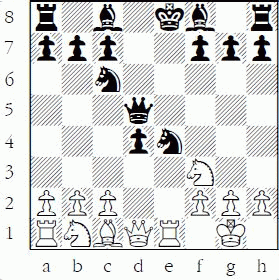
2-34 Black to play and win

2-35 White to play and win
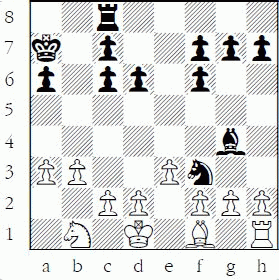
2-36 Black to play and win

2-37 White to play and win

2-38 Black to play and win

2-39 Black to play and win

2-40 White to play and win

2-41 Black to play and win

2-42 Black to play and win

2-43 Black to play and win

2-44 Black to play and win a piece

2-45 White to play and win

2-46 Black to play and win

2-47 Black to play and win a pawn
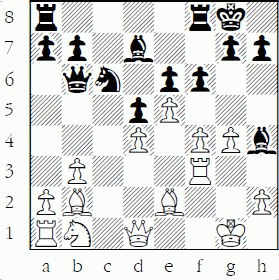
2-48 Black to play and win

2-49 Black to play and win

2-50 Black to play and win

2-51 White to play and win a pawn

2-52 White to play and win the bishop-pair

2-53 Black to play and win

2-54 Black to play and win

2-55 White to play and win

2-56 White to play and win

2-57 Black to play and win
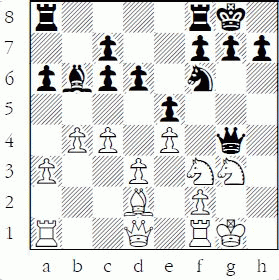
2-58 White to play and win a pawn

2-59 Black to play and win

2-60 Black to play and win

2-61 White to play and win

2-62 White to play and win

2-63 White to play and win
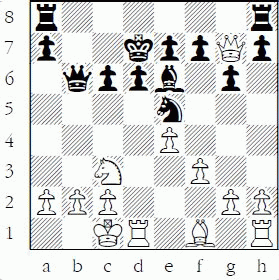
2-64 White to play and win

2-65 White to play and win

2-66 Black to play and win

2-67 Black to play and win

2-32: 1.Re1 f5 2.d3 the first one was easy – just remember the example!
2-33: 1.Nc3 making use of two pins on the d-and e-files! 1...Qa5 2.Nxe4.
2-34: 1...Qd7 1...Qd6?? 2.Nf5+. 2.Qc6 Rxd4 3.Qxd7+ Rxd7 4.Rxd7+ Nxd7 wins a piece.
2-35: 1.h3 1.Be2? Ne5 saves the piece; 1.gxf3?? Bxf3+ 2.Be2 Bxh1. 1...Bh5 2.Be2, but now the knight can’t move and guard the bishop, so a piece is lost...
2-36: 1...Rxe4 wins a piece. 2.Qxe4 If 2.dxe4 Qxd1+, but not 1...Qxe4??, when 2.dxe4 is good for White. 2...Qxe4 3.dxe4 Rxd1.
2-37: 1.Bd3 Also good is 1.Nxe5 Qxe5 2.Bd3. 1...Qg4 2.Rxe5+.
2-38: 1...Bh4 wins the queen.
2-39: 1...Nxe3 2.Qxe5 (2.Qxe3 Bg5 wins the queen.) 2...Nxd1 wins the exchange.
2-40: 1.Bxf6 is much better than 1.Rxf6. It wins the knight and the queen, since Qxg7# is threatened as well.
2-41: 1...Rxh3+ 2.Kg1 Rxd3.
2-42: 1...Nxg3 wins, e.g. 2.hxg3 Other lines are bad, too! 2...Qxh1+ 3.Ke2 Nd4+ 4.Kf2 Qxd1 would win the queen.
2-43: 1...Qg3+ 2.Kh1 Qxh3+ 3.Kg1 and now Black can play 3...hxg6 or even 3...Qg3+ 4.Kh1 Bxf2.
2-44: 1...Qg3+ 2.Kh1 Qxe5.
2-45: 1.Bxg6+ and Black loses a pawn and cannot castle, if 1...hxg6 2.Qxh8 Qxd4 3.Qxg8+ Ke7 4.0–0 White is winning.
2-46: 1...Bh3 2.g3 2.f4 Bxg2 3.Rfe1 (3.Rf2 Bf3+) 3...Bf3+ 4.Kf2 Bxd1 5.Rxd1. 2...Bxf1 3.Kxf1 wins the exchange.
2-47: 1...fxe5 2.fxe5 Rxf3 3.Bxf3 Nxe5.
2-48: 1...f6 is the simplest and best – it wins the pinned knight.
2-49: 1...f5 And White’s knight is pinned because of the mate on g2.
2-50: 1...Ra1 wins the queen.
2-51: 1.Qxg6 and White escapes with the g-pawn.
2-52: 1.cxd5 exd5 Or 1...Nxd5 2.Nb5 and 3.Nxd6. 2.Nb5 Qe7 3.Nxd6 Qxd6.
2-53: 1...Ne4 wins the pinned knight on c3.
2-54: 1...Qa5 wins the pinned knight on c3.
2-55: 1.Bb5 pins the queen to the king (don’t just save your queen!).
2-56: 1.Bb5 Qxb5 1...Bxc2+ 2.Ke1 is the same. 2.Qc8#.
2-57: 1...Qxg3+ The queen is immune. This tactic is often overlooked by beginners.
2-58: 1.Qxh6+ Once again, the queen cannot be captured because of the pin.
2-59: 1...Qxe2 2.Rxe2 f6 wins the bishop. But 1...f6? immediately does not work because of 2.Qc4+!, getting out of the pin and then the bishop can safely move.
2-60: 1...Re8 The queen is pinned because of the threat of ...Rxe1#! So White loses his queen for the rook in this common pattern.
2-61: 1.Rb1 wins the pinned bishop.
2-62: 1.Rd1 c6 2.c4 wins the knight.
2-63: 1.Qxe5 picks off the knight.
2-64: 1.Bh6 g6 2.Bxf8 wins the exchange and is superior to 1.Nxg7 winning a pawn. After 1.Bh6, it is better for Black to lose the exchange than play 1...Rfd8? 2.Bxg7! with mating threats.
2-65: 1.Qh5+ g6 2.Nxg6 wins a pawn and more. Not 1...Kf8?? 2.Qf7#; 1...Ke7? 2.Ng6+ wins a rook because of the pin. If 1...Kd8? 2.Nf7+ is a family fork winning the queen.
2-66: 1...a6 2.Ba4 Bd7 wins back the piece. This tricky pattern is very common. If 1...Bd7?, then 2.Nd4 saves everything. The idea of 1...a6 is to force the bishop to a square where the knight cannot guard it!
2-67: 1...Bxb4 wins the bishop.
Skewers are like “reversed” pins: a long-range piece attacks an opponent’s piece, while a second piece of equal or lesser value is behind it along the same line. In a pin the piece behind the attacked piece is of greater value. Another name for a skewer is an “X-ray attack.”
If the definition is confusing, the examples should make it very clear. Here is a case where the opponent’s attacked pieces are of equal value – but still greater than the attacker.
White to play and win

When White plays 1.Bb6, the bishop skewers the rooks. If the piece on d8 had been a queen or a king, then the rook on c7 would have been pinned.
The following is a simple skewer winning a rook. Notice that when the attacked piece is a king, there is almost always no escape!
Another name for a skewer is an “x-ray attack.”
White to play and win

1.Bc3+ Ke6 2.Bxh8 wins the rook. If the rook were on g7 instead of h8, it would still be lost. But if it was on f6, the king could guard it from f5 or e6, and then White would not win a whole rook, but only the exchange.
If the attacked piece is not a king, sometimes either piece can move thereby creating a greater threat and the skewer will fail. For example, if we remove the white f-pawn from our first diagram:
White to play

Now the skewer fails: 1.Bb6 Rf7+ (or 1...Rf8+) 2.Kg1 Rd6, and Black does not lose material.
In the next diagram, White checks to force a skewer on the following move.
White to play and win Black to play

1.Ra2+ Kb7 2.Rb2+ The king and queen are skewered and Black must lose his queen for the rook. 2...Kc7 3.Rxb8 Kxb8 4.h5 and White wins.
In the following simple example, White wins with a skewer.
White to play and win
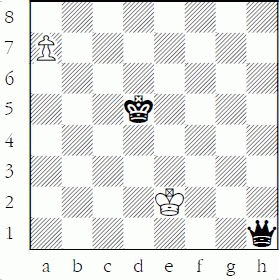
1.a8Q+ Ke5 2.Qxh1
Many skewers are fairly easy to spot since the pieces are “lined up” on a file (for a rook or queen) or a diagonal (for a bishop or queen). For instance, in the following diagram the knight and bishop are both on the seventh rank, so...
White to play and win a pawn

1...Qg7 Moving the queen to the seventh rank skewers the knight and the bishop.
In the following example, the two black pawns are lined up on the sixth rank.

1.Rg6 skewers the two black pawns. Notice that if White attacks a pawn from behind, then Black can just advance it, e.g., 1.Rf8? f5.
Tactical motifs can be combined with others to create a combination.
The following is a well-known promotion maneuver that makes use of a skewer.
White to play and win

1.Rh8! Rxa7 If Black does not capture the pawn, White eventually gets a queen on a8, even if Black checks the white king all the way up the board. 2.Rh7+ Kg6 3.Rxa7 wins the rook and the game.
Tactical motifs can be combined with others to create a combination. Here is a simple combination that is possible because Black cannot allow a killer skewer.
White to play and win

1.Bxd5+ This skewer cannot be ignored or else White wins the queen for a bishop, so 1...cxd5 2.Qxd5+ Double attack! 2...Kf8 3.Qxb7.
Here is a skewer example that could have occurred in a student’s game.
Black to play and win

The “long” moves 1...Qb8+ 2.Kf3 Qxh2 do the trick. Since skewers are performed by “long-range” pieces, don’t forget to look for long-range attacks!
What you have to lose on any given move is directly related to how good your position is.
If you are winning easily, you have a lot to lose because your position is very valuable.
When you are winning by just a little, you have a less to lose, and “only” getting a draw should not be as upsetting.
When you are drawing you have still less to lose, because all you can do is throw away a half point. When you are losing badly, you have nothing to lose, and if you make a mistake you were lost anyway.
2-68 White to play and win

2-69 White to play and win

2-70 White to play and win

2-71 Black to play and win

2-72 White to play and win

2-73 Black to play and win

2-74 White to play and win

2-75 White to play and win

2-76 White to play and win

2-77 White to play and win a piece

2-68: 1.Re1 Not 1.Nxe6?? Qxa1+. 1...Qf5 2.Rxe6+ wins at least a bishop.
2-69: 1.Rg8 Rxa7 2.Rxg7+ 1...Kf7 2.a8Q also wins the rook.
2-70: 1.gxf3+ Kg3 Black must continue to guard the queen. 2.Be1+.
2-71: 1...Nxd3 Note that the fork and pin does not work because of the check (defense!). 1...e4 2.Bxe4 Rfe8 3.Qb2+. 2.Qxd3 Bb5 The skewer wins the exchange.
2-72: 1.bxa5 Rxa5 2.Qxb6 wins the knight. If the black knight moves, then White wins the bishop.
2-73: 1...Qd3+ 2.Kb4 Qb1+ wins the queen.
2-74: 1.Bd3+ Kd4 1...Ke5 2.Ra5+. 2.Ra4+ Ke5 3.Ra5+ wins the black queen. After 1.Ra4+? Kf5 2.Ra5+ Kg6, Black is OK.
The most common sources of errors occur when a player:
1. Just plays the first reasonable move he finds, and does not attempt to find the best move.
2. Uses bad deductive logic and erroneously thinks a particular sequence is likely to occur, when in fact it likely would not.
3. Overlooks an opponent’s move, causing a tactical error.
4. Makes a mistake in visualization and thus misses a tactic or causes a misevaluation of the position.
5. Does not analyze until quiescence and thus misses a tactic.
6. Uses bad time management and for various reasons either plays too fast or too slow, the latter resulting in time trouble where he has to play too fast.
7. Selects a bad “plan” that he thinks will lead to future good (or equal) positions but which in fact leads to less favorable positions than expected.
8. Misevaluates the position and erroneously selects the wrong move.
2-75: 1.Rfe1 wins the bishop.
2-76: 1.Bh3 Qd4 2.Bxc8 wins the rook.
2-77: 1.Rxf4 Nxf4 2.Rf1 wins either the knight or the bishop.
There are three similar tactics that involve attacking or threatening two or more things at once:
An attack is a move that threatens to capture something on the next move. Since a threat is any move that can do damage on the next move (including an attack that must be met), you can think of all three of the above as types of double threats. However, chessplayers usually consider double threats as moves that threaten to do more than one thing on the next turn, but not all of these threats are attacks. If two or more of the threats are attacks, then it is a double attack. If one of the potential attacks is a check, that makes the double attack/threat all the more powerful.
For example, suppose you threaten to both checkmate and promote a pawn. Neither of those are attacks, so that is a double threat. Similarly, if one threat is an attack and the other is not (e.g. threaten to capture a queen and also to checkmate), such a tactic is still considered a double threat, but not a double attack.
Forks are named after the proverbial “fork in the road,” where you have a choice of which direction to go in. Some players define a fork to include all double attacks by the same piece, but I will restrict the definition of forks to double attacks by pawns and knights.
This section covers double threats and the next two sections feature double attacks and forks, respectively.
Here is an easy example of a double threat.
White to play and win

1.Re7 This is a multiple threat – it attacks the queen and threatens 2.Qg7#, or 2.Qf7+ Kh8 3.Qxh7#. 1...Qd4 The only move to save the queen and stop 2.Qg7#. 2.Re8#.
Here is another easy example. (D)
1.Qe4 threatens mate on h7 as well as 2.Qxe7, so the black bishop is lost, e.g. 1...Re8 2.Qxh7+ Kf8 3.Qh8#.
No one gets good at chess quickly, not without a lot of work.
White to play and win

Because of its great power, the queen is a common source of double threats and attacks.
Here is another one:
White to play and win

Here, 1.Qh6 threatens both 2.Qg7# as well as 2.Rh3 with an unstoppable mate on h7. If 1...Rg8, then White plays the standard queen sacrifice 2.Qxh7+ Kxh7 3.Rh3#.
White to play and draw

This is the end of the famous Réti study. It seems like White cannot either catch the black pawn or save his own, but he can! With 1.Ke5! White has the double threat of 2.Kd6 saving his pawn and helping it promote, plus a second threat of 2.Kf4 winning the black pawn and drawing immediately. Black can stop one threat or the other, but not both, e.g. 1...h3 2.Kd6 h2 3.c7 h1Q 4.c8Q Qh2+ 5.Kd5 or 5Ke7 Draw If 5.Ke6?? Qh3+, and the skewer wins.
Here is another endgame example of a double threat.
White to play and win

1.Ra7 The double threat of 2.Rxa6 and 2.Ra8+ wins, e.g. 1...Bb5 (1...Bc8 2.Ra8 wins) 2.Ra8+ Be8 3.Rb8 Zugzwang. 3...Kg8 4.Rxe8+ etc.
Knowing general tactical patterns reaps much bigger rewards than memorizing traps or particular move sequences. Using general patterns, you not only find tactics more often in “new” positions, but do so more quickly and efficiently. You are always a much better player if you don’t have to “figure out” a tactic, but rather have its patterns in your mental “tactical database.” Furthermore, in similar positions where the tactic does not work, you are able to more quickly recognize what conditions are different that cause the pattern to fail. Either way, you play better, quicker, and more efficient chess.
2-78 White to play and win

2-79 White to play and win

2-80 White to play and win

2-81 Black to play and win

2-82 White to play and win a pawn

2-83 White to play and win
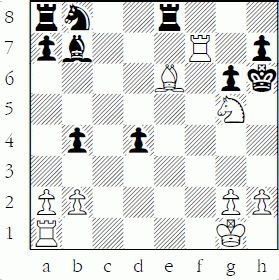
2-84 White to play and win

2-85 White to play and win
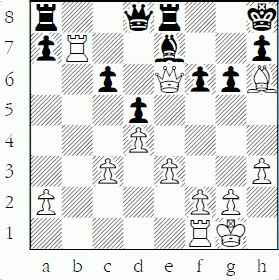
2-86 Black to play and win

2-87 White to play and win

2-88 White to play and win

2-89 Black to play and win

2-90 Black to play and win

2-78: 1.Qd5 threatens Qxe4 and Qxf7#. 1...Qe7 1...Ng5 2.Bxg5. 2.Qxe4.
2-79: 1.Rxa8 Rxa8 2.Qe4 threatens the rook and mate on h7.
2-80: 1.Qf4 threatening the knight and Nf7+, so if 1...Nxb3 Or 1...Bxe5 2.Qxe5+ wins the knight. 2.Nf7+.
2-81: 1...Qd4 threatens 2...Qxe5 and 2...Qxf2#.
2-82: 1.dxe5 wins a pawn since 1...Nxe4? 2.Qd5 is similar to #78.
2-83: 1.h4 has the double threat of Rxh7# and Rxb7.
2-84: 1.Qg2 threatens Qxd5 and Qg7#, as in Adams-Ward 2001.
2-85: 1.Qf7 threatens Qg7#, but 1...Rg8 allows the second threat of 2.Rxe7 when the rook on e8 moves.
2-86: 1...d4 threatens the queen and mate on g2.
Most games between lower rated players are won or could be won on tactics, so studying tactics when you are lower rated is much more important than anything else. When looking for tactics – for either player – look for checks, captures, and threats, in that order.
2-87: The end of the famous Saavedra study. 1.Kb3 threatens both 2.Kxa4 and 2.Rc1#, so White wins the rook.
2-88: 1.Qh5 threatens the bishop and mate.
2-89: 1...Qg5 threatens mate and continues to threaten the knight. 2.Nf3 Bxf3 and the pin wins!
2-90: 1...Nb4 threatens the queen and Nxc2#. 2.Rb1 Qxb1+ Counting correctly! 3.Nxb1 Nxd5 wins a rook.
A double attack is a move that threatens to make two (or more) beneficial captures on the following move, not all of which can be stopped. According to my unofficial survey, the double attack is the single most common tactical motif, if we don’t count counting as a motif (pun intended).
For example, after 1.d4 d6 2.Bg5 c6 3.e3 Black has a winning double attack.

3...Qa5+ picks up the white bishop on g5.
In the next example, a bishop makes a double attack.
White to play and win

1.Bd5+ wins the rook and the game.
Here is a common double attack theme with a rook check.
White to play and win

1.Rd8+ Kf7 2.Rxc8 wins the bishop.
A double attack is a move that threatens to make two (or more) beneficial captures on the following move, not all of which can be stopped. The double attack is the single most common tactical motif. All chess pieces can make a double attack.
Here is the rook at work again, this time without the benefit of a check.
White to play and win

1.Rd5 snares one of the knights.
Kings can double-attack, too.
White to play and draw

1.Ke5 wins a piece and leaves Black with insufficient mating material. If the bishop had been on e6 instead of f5, White would still win a piece.
A common beginner error is to meet an attack with some random counterattack. This can be very dangerous if your opponent can meet the counterattack with a second attack. The following example should suffice.
After 1.e4 e6 2.d4 d5 3.Nf3 Nf6 4.e5, the counterattack 4...Bb4+?? is a bad blunder.

5.c3 and now Black has compounded his problems by having two units attacked and must lose a piece.
A variation from Damiano’s Defense illustrates a well-known double-attack: 1.e4 e5 2.Nf3 f6? 3.Nxe5 fxe5 4.Qh5+ g6. Or 4...Ke7 5.Qxe5+ Kf7 6.Bc4+ with a winning attack.
White to play and win

5.Qxe5+ Qe7 6.Qxh8 Qxe4+ 7.Kd1 and White is winning.
2-91 Black to play and win

2-92 White to play and win

2-93 White to play and win

2-94 White to play and win

2-95 Black to play and win

2-96 White to play and win

2-97 White to play and win

2-98 Black to play and win

2-99 Black to play and win

2-100 Black to play and win

2-101 White to play and win

2-102 White to play and win

2-103 White to play and win

2-104 Black to play and win

2-105 Black to play and win

2-106 Black to play and win
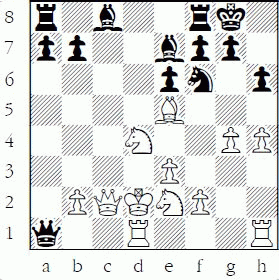
2-107 White to play and win

2-108 Black to play and win

2-109 White to play and win back his pawn

2-110 Black to play and win a pawn

2-111 White to play and win a pawn

Look for unguarded enemy pieces and the ways your pieces can double attack or trap them.
2-91: 1...Nxg5 2.Nxg5 Qa5+ wins the knight on g5. 1...Qa5+? is not as accurate because of the attraction theme 2.b4!, only losing a pawn.
2-92: 1.Rxa8+ Bxa8 2.Rd8+ wins the bishop.
2-93: 1.Bf3 Qxg5 1...Bg4 2.Bxg2 (Count!!) 2...Bxd1 3.Bxc6+. 2.Bxc6+ Bd7 3.Bxa8 wins a rook.
2-94: 1.Rh4! Nxf2+ 2.Ke2 wins a piece.
2-95: 1...Nxd3 2.Rxd3 2.Kf3 Nc5 wins another pawn. 2...Bxe4+ wins.
2-96: 1.Qa4+ wins the bishop on b4.
2-97: 1.Rd8+ wins the queen.
Always assume your opponent will make the best move. Never make a bad move and hope your opponent will make a worse one.
Playing chess is primarily a series of puzzles, where you have to answer the question: What is the best move?
The primary goal of most moves is to make the best move you can find, given the time constraints.
2-98: 1...Rf4 2.Qxc6 Bxf7 wins the bishop. Black can also win the piece with 2...R4xf7 3.Rxf7 (3.Qxg6? Rxd7) 3...Bxf7.
2-99: 1...Bd4 wins a knight. This is also a common tactical pattern for White in the Ruy Lopez opening with colors reversed.
2-100: 1...Qa5+ wins the bishop.
2-101: 1.Qa4+ But not 1.Qe2+, when 1...Qe7 saves the knight through the pin. 1...c6 1...b5 2.Qxb5+. 2.Qxc4 wins the knight.
2-102: 1.Bd2 double attacks the bishop on a1 and the knight on a5, thus White gets two pieces for the rook.
2-103: 1.f3 and two black pieces are attacked by pawns, so one of them is lost.
2-104: 1...Qc5+ 2.Nd4 Or 2.Kf3 Qxb5. 2...Qxd4+ wins the knight. Note 2...Qxd4 is slightly better than 2...Nxd4, since Black is now ahead a piece and wants to force the trade of queens.
2-105: 1...Qxe4+ 2.Be3 Qxg6 wins the knight, but not 1...hxg6?? 2.Qxh8 winning the exchange, because the black h-pawn was pinned.
2-106: 1...Qa5+ attacks the king and the white bishop on e5. 2.Kc1 Qxe5.
2-107: 1.Bxg5 hxg5 2.Qxg5+ Kh7 3.Qxf6 wins back the piece with two pawns interest.
2-108: 1...Qe3+ 2.Kh1 Qxg5 wins the white knight.
2-109: 6.Qg4 hits the e-pawn and the g-pawn.
2-110: 1...Nxe5 2.fxe5 Qd4+ wins a pawn. Or 1...Qd4+ first.
2-111: 1.Qe6 attacks the knight and the e-pawn.
As mentioned in Section 2.4, double attacks by knights and pawns are called “forks.” Here is a simple pawn fork:
Black to play and win

1...e5 wins a piece.
Like many tactics, pawn forks are often created by clever maneuvering.
Black to play and win

1...Nxd4 2.Qxd4 e5 is correct to set up the previous example, but not the hasty 1...e5? when 2.Nxc6 saves the day for White.
After 1.e4 e5 2.Nf3 Nc6 3.Bc4 Nf6 4.Nc3, a well-known counter is the “center fork trick.”
Black to play
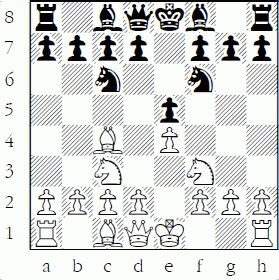
4...Nxe4 5.Nxe4 d5 wins back the piece with a free and easy game.
But be careful with the center fork trick; it does not always work to your advantage! For example, after 1.e4 e5 2.Nf3 Nc6 3.Nc3 Nf6 4.Bc4 Bc5 5.0-0, does it still work?
Black to play

5...Nxe4?? 6.Nxe4 d5 7.Nxc5 No, the trick does not work with a bishop on c5!
One of the most common knight forks often occurs early in the game on the c7-square. A knight fork of the king, queen, and another piece is often called a “family fork.”
White to play and win

1.Nxc7+
Of course, c7 is not the only square where such a fork can occur.
White to play and win

1.Nd7+ forks the king, rook, and queen.
Black has a choice of wins in the following example, but the knight fork is easy.
Black to play and win

1...Nxc3+ wins the queen.
In the following position, Black has plenty of wins, but the knight fork is the most devastating.
Black to play and win

1...Rad8 and 1...Qxg2 are good, but 1...Nc3+ winning the queen is best! In the following position, White can win with clever play.
Basic tactic recognition greatly aids in the solution of more difficult combinations.
White to play and win

1.e8N+ But not the automatic 1.e8Q?? Qc7#. 1...Ke5 2.Nxg7 will win if White is careful.
2-112 Black to play and win

In chess, if you learn to do the little things on each move: take your time, count the material effect of your move, and check for basic tactics, then you will soon find that these are not so little!
2-113 White to play and win

2-114 Black to play and win

2-115 Black to play and win

2-116 White to play and win

2-117 White to play and win

2-118 Black to play and win

2-119 Black to play and win
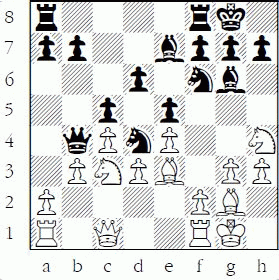
2-120 White to play and win

2-121 Black to play and win
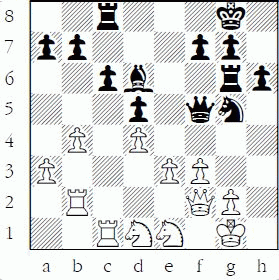
2-122 White to play and win

2-123 White to play and win

2-124 White to play and win
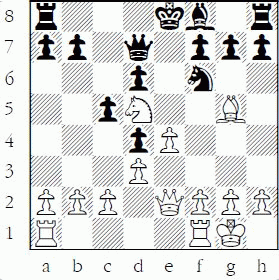
2-125 Black to play and win

2-126 White to play and win

2-127 Black to play and win

2-128 White to play and win

2-129 Black to play and win a piece

2-112: 1...e5 2.dxe5 dxe5 3.Bg3 e4 forks the knight and bishop and wins a piece for a pawn.
2-113: 1.Bb5 A pin forces the knight fork! That makes this a basic “combination” since it combines two or more motifs. 1...Qxb5 2.Nxc7+ Kd8 3.Nxb5 and White wins the queen no matter how Black plays.
2-114: 1...d5 2.exd5 exd5 3.Bb3 d4 forks the bishop and knight.
Many players confuse the concepts of analysis and evaluation. A definition of each might be:
Analysis is the process by which a player, usually through a process of “I move here, he moves there” logic, reaches positions to evaluate in order to determine the best move. A more general definition of analysis is “the thinking process used to determine the best move.” This contrasts to the strategic thinking process, which is used to arrive at a plan, although these two processes are not completely independent. Analysis makes use of many skills such as deductive logic and visualization.
Evaluation is the process of examining a position and deciding which side is better, by how much, and why (the “why” is usually the key to your plan). You can consider evaluation to happen “after” each candidate move is analyzed or, by the more general definition of analysis, evaluation is just a part of analysis. Evaluation requires experience; a talented beginner is often good at analysis but less so at evaluation (unless one side is way ahead).
2-115: 1...Qe3+ 2.Kh1 Nf2+ But not 2...Qxg5? 3.Qxd3 and Black wins nothing. The text forks the queen and king and wins the exchange after 3.Rxf2 Qxf2.
2-116: 1.Ne7+ Rxe7 2.Rxd8+ The fork forces a removal of the guard, thus winning the exchange. Another combination.
2-117: 1.Nb5 Now 2.Nbc7 is a threatened mate, so Black cannot just play ...Rb8 to save the fork. Therefore, 1...Qa5+ 2.Bd2 Qa4 3.Ndc7+ Kd8 4.Nxa8 captures the rook.
2-118: 1...Nd5+ The pin allows the fork, winning the queen for a knight.
2-119: 1...Qxc3 2.Qxc3 Ne2+ 3.Kh2 Nxc3 is an example of a pseudo-sacrifice. Black gives up his queen, but wins it back, netting a knight in the process.
2-120: 1.Ndb5+ is the easiest, as 1...axb5 2.Nxb5+ Kc6 3.Nxc7 wins the queen for two knights and White still has a devastating attack.
2-121: 1...Nh3+ Again, the pin makes the fork work, winning the queen for a knight.
2-122: 1.Qxd5 Qxd5 2.Nc7+ Kd8 3.Nxd5 This is a common sacrificial pattern.
2-123: 1.d5 White wins a piece for a pawn.
2-124: 1.Bxf6 gxf6?? recapture, White wins a piece anyway, by saving his bishop on the next move. 2.Nxf6+ would win the queen.
2-125: 1...Nbxd5+ 1...Nfxd5+ is equally good. 2.cxd5 Nxd5+ 3.Kd2 Nxc3 wins the queen.
2-126: 1.Nf6+ A pin allows an easy knight fork winning the queen.
2-127: 1...Qxa1 1...Nc2+ 2.Qxc2 Qxa1+ 3.Qc1 only wins the exchange and leaves White a little worse. 2.Qxa1 Nc2+ 3.Kd1 Nxa1 wins a full rook.
2-128: 1.Nxc7+ Kd8 2.Qxe7+ Kxe7 3.Nxa8 The pin of the black queen on the first move allows the knight to safely get to c7 and then, once the white queen is safely traded off, to capture the rook.
2-129: 1...g5 and black wins a piece. Black is happy to win the piece at the price of weakening his kingside.
Removal of the guard is one of the most common tactics in chess and surely the most underrated. The concept is simple: attack or capture a defender and the piece it defends then becomes vulnerable.
White to play and win

White removes the guard on the black knight with 1.g3 and then the bishop on f4 either can be captured or else it must abandon its defense of the knight.
Here is another example:
White to play and win

Black’s rook is guarding the queen, but it is also guarding the back rank. So White simply captures the queen with 1.Qxe3 and the rook dare not recapture because of 1...Rxe3 2.Rf8#. This sequence is much better than 1.Rf8+ Rxf8 2.Qxe3, which leaves White ahead a queen for a rook and two pawns, but few chances to win. When you see a good move, look for a better one! The overburdening of the rook after 1.Qxe3 is a type of removal of the guard called an overworked piece. When a piece is overworked, simply make it do one of its jobs and then it cannot do the other one!
However, it’s not always so easy, for instance after 1.e4 Nc6 2.d4 d5 3.exd5 Qxd5 4.Nf3 Bg4 5.Be2, it looks as though Black can win the d-pawn by capturing the defending knight on f3:

After 5...Bxf3 6.Bxf3 Qxd4??, the guard has been removed and the pawn captured, but...
White to play and win

7.Bxc6+ wins the queen with a removal of the guard tactic in return!
Here is another common removal of the guard pattern.
When a piece is overworked, simply make it do one of its jobs and then it cannot do the other one!
White to play and win
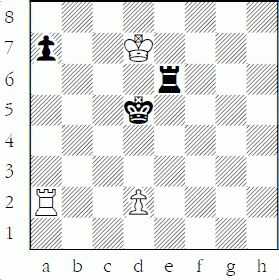
1.Ra5+ and the king can no longer guard the rook: 1...Kc4 2.Kxe6 wins the black rook. Unlike the previous example where the guard is captured, when the guard is forced to move away this type of removal of the guard can be considered deflection.
The following is common removal of the guard pattern in the opening.
White to play and win

1.Bxf7+ Kxf7 2.Qxd8 wins the queen.
However, even a slight alteration in this pattern may be insufficient.
White to play

1.Bxf7+ Kxf7 2.Qxd8 Bb4+ Discovered attack! 3.Qd2 3.Bd2 Rxd8. 3...Bxd2+ wins back the queen. White only wins a pawn. Therefore, he could just as well play 1.Qxd8+ Kxd8 2.Bxf7 with a similar win of material.
It is just as important to avoid losing pieces as it is to win them!
The next diagram shows another very common error that features the removal of the guard theme. Black has just played ...Bg4?? with the belief that this “gains a tempo” for his development.
White to play and win

1.Bxf6 Removing the guard and hitting the enemy queen. 1...Qxf6 No better is 1...Bxd1 Bxd8 and White wins a piece. 2.Qxg4 again winnig a piece.
In the Ruy Lopez opening, Black can play 1.e4 e5 2.Nf3 Nc6 3.Bb5 a6, because if White tries to remove the guard on the e-pawn right away, Black has a tactic to win the pawn back and more:
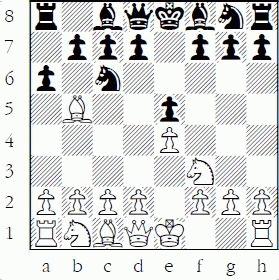
4.Bxc6 dxc6 5.Nxe5? Bobby Fischer popularized 5.O-O in the Exchange variation. Now Black can win back the pawn.

5...Qd4 with a double attack on the e-pawn and knight, giving Black a good game.
If White plays the more common 1.e4 e5 2.Nf3 Nc6 3. Bb5 a6 4.Ba4 Nf6 5.O-O Be7 6.Re1, now he is threatening to remove the guard with Bxc6 and Nxe5. So, if Black now plays 6...O-O? (better is 6...b5, removing the attacker from the knight, and thus preventing removal of the guard!), then White can win a pawn: (D)
7.Bxc6 dxc6 8.Nxe5 wins the e-pawn as 8...Qd4 9.Nf3 saves the day and leaves White a pawn ahead. So the removal of the guard tactic frequently occurs in the most common openings!

2-130 White to play and win a pawn

2-131 Black to play and win

2-132 White to play and win

2-133 White to play and win

2-134 White to play and win

2-135 White to play and win

2-136 White to play and win

2-137 White to play and win a pawn
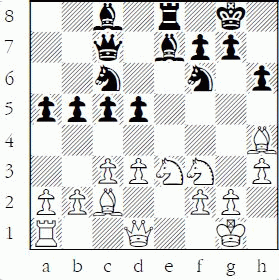
2-138 Black to play and win

2-139 White to play and win

2-140 White to play and win

2-141 Black to play and win

2-142 White to play and win a pawn
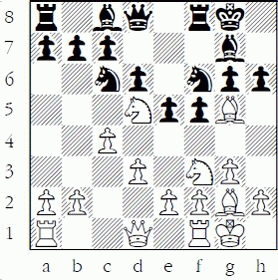
2-143 Black to play and win

2-144 Black to play and win a pawn
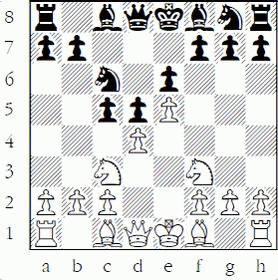
2-145 Black to play and win a pawn

2-146 Black to play and win

2-147 White to play and win

2-148 White to play and win

2-149 Black to play and win

2-150 Black to play and win

2-151 White to play and win

2-152 White to play and win

2-153 Black to play and win

2-154 White to play and win

2-155 Black to play and win

2-156 White to play and win a pawn
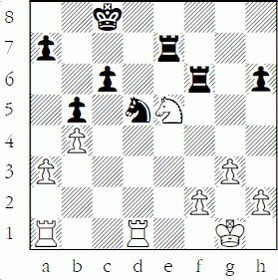
2-157 Black to play and win a piece

2-158 White to play and win

2-159 White to play and win

2-160 Black to play and win

2-161 Black to play and win

2-162 Black to play and win a pawn

2-163 White to play and win material

2-164 Black to play and win

2-165 White to play and win

2-166 Black to play and win a pawn

2-167 White to play and win

2-168 Black to play and win a pawn

2-169 Black to play and win

2-170 White to play and win a pawn

2-171 Black to play and win a pawn

2-172 Black to play and win

2-173 Black to play and win
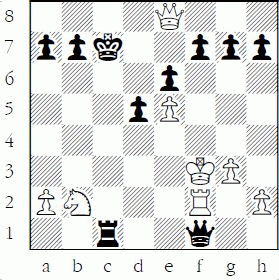
2-174 White to play and win

2-175 White to play and win a piece

2-176 White to play and win

2-177 Black to play and win

2-178 Black to play and win

2-179 White to play and win

2-180 White to play and win

2-181 Black to play and win a pawn
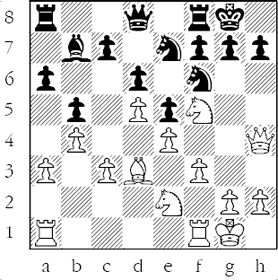
2-182 Black to play and win a pawn

2-183 White to play and win

2-184 White to play and win

2-130: 1.Bxg6 Bxh3 1...fxg6 2.Rxe6. 2.Bxf7+ The bishop is a desperado – it is lost anyway, so it will sell itself as dearly as possible. 2...Rxf7 3.gxh3.
2-131: 1...Rg1+ 2.Kxg1 Qxe1+ picks up the queen for a rook.
2-132: 1.Rxd5 Bxd5 2.Rxf6 wins two pieces for a rook (and gets rid of the bishop-pair), worth about two pawns, but more importantly, it leaves White with an easily winning position.
2-133: 1.Bxe6 fxe6 2.Qxg4 wins the knight.
2-134: 1.Bxg7 1.Rxf6 also works, e.g., 1...Bxf6 2.Bg7! with mate on h7 or h8 next. 1...Kxg7 2.Rxf6 exf6 2...Rh8 3.Rxf7+ Kg8 and White is up a piece and will soon mate after 4.Rh7; 2...Kxf6 3.Rf1+ Kg7 4.Qh7#.
2-135: 1.Qxb7 and if 1...Qxb7?? 2.Rxe8# or 1...Rxe1+ 2.Rxe1 Qxb7?? 3.Re8#.
2-136: 1.Rxd4 Nxd4 2.Kxf2 and White wins a piece.
Players need to study and learn tactics in increasing order of complexity. The ability to play combinations in a timed game is highly dependent upon the player’s ability to recognize the basic, underlying motifs accurately and extremely quickly.
2-137: 1.Bxf6 Bxf6 2.Nxd5 wins the d-pawn.
2-138: 1...Qe1+ 2.Qf1 Bh2+ wins the queen.
2-139: 1.Rxf6 Qxf6 2.Bxd5+ Kg7 3.Bxa8 wins the pawn and the knight.
2-140: 1.Nxd7 Qxd7 2.Qxe6 wins a piece for White.
2-141: 1...Rxf3 2.Bxf3 Nf2+ If 2...Qh2+?? 3.Qxh2. 3.Qxf2 Qxf2 wins the queen.
2-142: 1.Nxf6+ Bxf6 2.Bxh6 wins the h-pawn.
2-143: 1...a4 2.Nc1 Ba5 and 3...d2 can only be stopped by 3.Nxd3. On 2.Nd2 Bd4, the b-pawn falls with an easy win.
2-144: 1...cxd4 overworks the knight, so that 2.Nxd4 Nxe5 wins the e-pawn. If 2.Nb5, then 2... Bb4+, and Black has an advantage.
2-145: 1...Ra4+ removes the defender of the g-pawn. 2.Kf3 Bxg5.
2-146: 1...Nd4+ 2.Kf2 Qxd1 wins the queen.
2-147: 1.b3 Rb4 2.a3 2.c3 is also good. 2...Be3 If 2...Rb6 3.Rxd4. 3.axb4 Bxd2+ 4.Kxd2 wins a piece.
2-148: 1.Bh7+ wins the queen for a bishop, which is superior to just 1.Rxf8+ winning the queen for a rook and leaving White down a pawn.
2-149: 1...b5+ 2.Ka5 Rxb3 wins the rook.
2-150: 1...Nxd4 2.hxg4 If 2.Nxd4? Qh2# is the point. 2...Nxe2+ 3.Nxe2 Black wins a queen and pawn for two knights. This is a famous trap pattern in many openings and therefore well worth knowing.
2-151: 1.Bxa6 bxa6 2.Nxc7+ wins at least the exchange.
2-152: 1.Rd1+ Kc5 2.Kxe6 wins the rook.
2-153: 1...Bxf3 Even better than 1...Nxf3+ 2.gxf3. 2.gxf3 Nxh3+ 3.Kh2 Qh4 4.Rh1 Nf4+ and Black wins easily.
2-154: 1.Nd5 Overworking the knight, which is guarding the mate on h7. 1...Re8 If 1...Nxd5 2.Qxh7#. 2.g5 2.Nxf6+ exf6 3.Qxh7+ Kf8 4.g5 also wins. 2...Nh5 3.Rxh5 gxh5 4.Nf6+ exf6 5.gxf6 and Black must give up his queen to avoid checkmate.
2-155: 1...Rd2+ 2.Kc4 Kxe4 wins the rook.
2-156: 1.Nxc6 Rxc6 2.Rxd5 wins a pawn.
2-157: 1...d5 2.Rxa7 dxe4 wins the bishop.
2-158: 1.Kh2 attacks the knight, which is guarding the bishop, so one of them is lost.
2-159: 1.Rh8+ wins a queen for a rook – with mate soon to follow.
2-160: 1...Ba6 A skewer sets up removal of the guard. 2.Qb6 Bxd3 3.Bxd3 Qxc1+ wins the bishop.
2-161: 1...Rxe2+ 2.Rxe2 Qxd4+ wins the queen.
2-162: 1...Rxd2 2.Bxd2 Nxe5 wins the e-pawn, as the knight is overworked. 1...Nxe5 also works: 1...Nxe5 2.Nxe5 Rxd2 3.Bxd2 Rxd2 or 1...Nxe5 2.Rxd3 Nxd3.
2-163: 1.Rxe6 Qxe6 2.Rxg4 wins two pieces for a rook.
2-164: 1...Rd1+ 2.Rxd1 The only move! 2...Qxc6 winning a queen for a rook. This is a common – and effective – pattern.
2-165: 1.Rxa5 The double attack fails: 1.Qa3? Nec6. 1...Qxa5 2.Bxe7 wins two pieces for a rook.
2-166: 1...Ne5 2.Qd1 2.Qxd4?? Nxf3+ wins the queen on a discovery. 2...Nxc4 wins the c-pawn.
2-167: 1.h6+ Kh7 2.Qxf6 wins the queen.
2-168: 1...Bxh3 2.Bxh3 Qxd5 is a common pattern that wins a pawn.
2-169: 1...Qxg2+ 1...Qf1+ 2.Rg1 Qxg1+ is a similar. 2.Kxg2 gxf6 winning a rook.
2-170: 1.Bxf6+ exf6 2.Qxd6 wins the d-pawn.
2-171: 1...Rb3+ 2.Kf2 exf4 wins the f-pawn.
2-172: 1...e6 2.Rxf7+ Moving the knight and losing the rook is even worse, as is moving the rook and losing the knight. It is better to lose the exchange than lose a piece! 2...Kxf7.
2-173: 1..Rc3+ wins a rook.
2-174: 1.c5 wins either the bishop or the knight it is guarding. After 1...Nd5 2.cxd6 cxd6 3.e7, White is winning.
2-175: 1.Rd5+ Ke6 2.Rdxc5 wins the bishop.
2-176: 1.Rxd6 cxd6 2.Rxe7 wins two pieces for a rook.
2-177: 1...a2 2.Rxb5+ If 2.Kxa2 Kxb4. 2...Rxb5+ 3.Kxa2 and Black wins a rook.
2-178: 1...Rd8 A skewer. 2.Qa1 The queen must guard the rook, but 2...Qxe4 wins the bishop.
2-179: 1.Nxf6+ Rxf6 If 1...Kf7 2.Nxe8 Rxd2 3.Rxd2 Rxe8 also leaves White ahead a rook. 2.Qxd8 wins a rook.
2-180: 1.Bxh3 Qxh3 1.Rxc6 wins a piece.
2-181: 1...Nxf5 2.exf5 Nxd5 wins the d-pawn. If 3.f6?, then 3...Nxf6.
2-182: 1...Nxa3 2.bxa3 Qxc3 wins an important pawn. This is a common “Open Sicilian” tactic for Black.
2-183: 1.Bxf6 Bxf6 2.Rxf6 Qxf6 3.Qxc5 wins two pieces for a rook.
2-184: 1.Nxd5 Bxd5 1...Bxg5 2.Nxb6 wins the queen. 2.Bxe7 wins a piece.
When a piece moves and clears a line for another piece that is called a discovery, when the discovery includes an attack on another piece it is a discovered attack. If the piece being attacked is the king, it is a discovered check. If both the piece that moves and the discovered piece are checking the king, then it is a double check.
The simplest example of a discovered attack can come on the very first move after 1.b4.
Black to play

1...e5 (or 1...e6) allows the bishop on f8 to make a discovered attack on the white pawn at b4.
An example of a discovered double attack is as follows 1.Nh3 d5 2.b4 Nf6 3.Nf4: (D)
Black has a discovered attack that wins the b-pawn: 3...e5 Attacking the knight with the e-pawn and attacking the b-pawn with the f8-bishop. 4.Nd3 e4
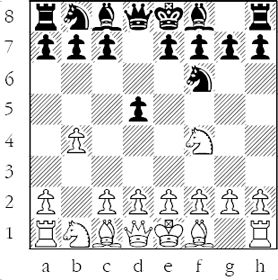
Removing the guard. 5.Nc5 b6 Removing the guard, again. 5...a5 is also very good. 6.Nb3 Bxb4 and the pawn is won.
A common tactic is winning an undefended piece with a discovered check.
White to play and win

1.Bxg6+ Even if this bishop could be captured, White would gladly make the same move. As it is, White wins the queen for nothing. 1...Ke7 2.Qxd4.
Here is the same idea from a famous trap in the French Defense. 1.e4 e6 2.d4 d5 3.e5 c5 4.c3 Nc6 5.Nf3 Qb6 6.Bd3 cxd4 7.cxd4 Nxd4??:
White to play and win

8.Nxd4 Qxd4? 9.Bb5+ wins the queen. Another common motif occurs when one side fails to heed the “knights before bishops” guideline. For example after 1.e4 c5 2.Nf3 d6 3.Bc4 Bg4:

4.Bxf7+ 4.Ne5 is great after 4...Bxd1?? 5.Bxf7#, but Black can just play 4...dxe5 and spoil the fun. 4...Kxf7 5.Ng5+ Discovering an attack on the bishop. 5...Kg6 6.Qxg4 and White has won a pawn and exposed Black’s king.
Every beginner’s book shows the following double check played in the off-hand game Réti-Tartakower, 1910, so we will also include this famous example.
1.e4 c6 2.d4 d5 3.Nc3 dxe4 4.Nxe4 Nf6 5.Qd3 e5 6.dxe5 Qa5+ 7.Bd2 Qxe5 8.O-O-O Nxe4??:

9.Qd8+! Kxd8 10.Bg5++ 1–0 If 10...Ke8 11.Rd8# or 10...Kc7 11.Bd8#.
Next, there is the spectacular “windmill” or “see-saw” check.
Black to play and win
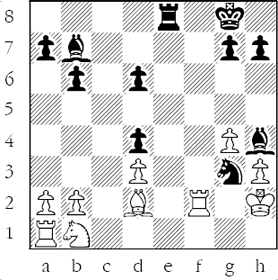
Here Black has a discovered attack on the rook by moving his knight. But where is a safe place to move it? He can play 1...Ne4 and if 2.dxe4 Bxf2 wins the exchange, but White can just move the rook instead of capturing the knight. So how about the fanciful 1...Nf1+! Now if 2.Kg1 Bxf2 wins at least the exchange, so 2.Rxf1 is to be expected. But then after 2...Re2+ 3.Kg1 Rg2+ 4.Kh1 White faces the dreaded “windmill” series: (D)
Now after 4...Rxd2+ 5.Kg1 Black repeats the discovery threat with 5...Rg2+ 6.Kh1 and then mops up the second rank with 6...Rxb2+ 7.Kg1 Rg2+ 8.Kh1 Rxa2+ 9.Kg1 and now ust 9...Rxa1. Black could have even picked up the g-pawn with ...Rxg4+ Kh2 Rg2+ by using the discovery along the file instead of the rank. In any case, if you can create a windmill attack, it is worth a lot of trouble or material to set it up!

2-185 White to play and win

2-186 Black to play and win

2-187 How should White finish Black off?

2-188 Black to play and win

2-189 White to play and win

2-190 White to play and win

2-191 White to play and win a pawn

2-192 Black to play and win

2-193 White to play and win a pawn

2-194 Black to play and win

2-195 Black to play and win

2-196 Black to play and win a pawn

2-197 Black to play and win

2-198 Black to play and win

2-199 Black to play and win

2-200 White to play and win

2-201 Black to play and win

2-202 Black to play and win a pawn

2-203 White to play and win

2-204 White to play and win

2-205 White to play and win

2-206 White to play and win

2-207 Black to play and win

2-208 Black to play and win

2-209 White to play and win

2-210 Black to play and win a pawn

2-211 White to play and win a pawn

2-212 White to play and win

2-213 White to play and win

2-214 Black to play and win

2-215 Black to play and win

2-216 Black to play and win

2-217 Black to play and win
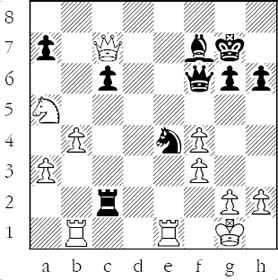
2-218 Black to play and win a pawn


2-220 White to play and win

2-221 White to play and win

2-222 Black to play and win

2-185: 1.Nf6+ gxf6 2.Rxe8+ wins an exchange.
2-186: 1...g2+ 2.Nxh4 Or 2.Ke2 Qxe4+ 3.Kf2 gxh1Q. 2...gxh1Q+ 3.Ke2 Qxe4+ wins back the queen and much more.
2-187: 1.Rg6+ wins the queen. In the game, White played 1.Re8+ Rxe8 2.Qxf5?? (2.Qxe8 wins). But Black blundered back with 2...Nf2+?? (an incredible win for Black is 2...Re1+ 3.Bf1 Rxf1+ 4.Kg2 Ne3+ 5.Kh2 Nxf5) 3.Kg1 and White won easily.
2-188: 1...Nd4 wins the knight on e5 with a discovery, because of the attack on the queen.
2-189: 1.e5 Nd5 Else 2.Bxa8. 2.Nxd5 exd5 3.Qxd5+ Kh8 4.Qxa8 wins a rook anyway.
2-190: 1.e5 dxe5 2.fxe5 Nfd7 3.Bxb7 wins at least the exchange.
2-191: 1.exf5 gxf5 2.Qxe7 wins the e-pawn.
2-192: 1...Nxf3+ 2.Rxf3 Bxd4+ wins the queen.
2-193: 1.Bxf7+ Kxf7 2.Ne5+ Ke8 3.Nxg4 is a common pattern to win a pawn and prevent Black from castling.
2-194: 1...Nxd5 wins a piece since 2.Qxd5? Bxh2+.
2-195: 1...Nxc3+ wins the queen, similar to the Petroff’s trap in Chapter 6.
2-196: 1...Nxe4 2.Nxe4 Bxg5 still gets the pawn. 2.Bxe7 Qxe7 3.Nxc6 bxc6 is a common motif that everyone should know.
2-197: 1...Nxe4 2.Bxe7 Qxe7 3.Qe2 Qb4+ is tricky, but Black gains a piece. If 2.Bxe4, then 2...Bxg5 3.Qh5 h6 wins a piece.
2-198: 1...Rd2+ 2.Kg1 Rxd1+ wins at least a rook.
2-199: 1...Bxg2+ Much better than just 1...Qxd2. “When you see a good move, look for a better one!” 2.Kxg2 Qxd2+ 3.Kg1 Rxb3 wins plenty of material.
2-200: 1.Bxc5+ wins the exchange and a pawn.
2-201: 1...Qg5+ wins the queen.
2-202: 1...dxc4 2.Bxc4 Nxd4 wins the d-pawn.
2-203: 1.Bxh7+ Kxh7 2.Qxb2 wins the queen for a bishop.
2-204: 1.Nxc5 wins a piece because of 1...Qxc5? 2.Bxh7+.
2-205: 1.Rxd8 1.Ng6+ hxg6 2.Qxa4 Rxd1+ 3.Qxd1 Rxe6 only wins a queen for rook and knight. 1...Rxd8 2.Ng6+ hxg6 3.Qxa4.
2-206: 1.Nh6+ gxh6 2.Qxf7+ wins the queen.
2-207: 1...Kd5+ 2.Kb7 Kxe5 wins the bishop.
2-208: 1...Nxf3+ 2.gxf3 Rxd3 3.Bxd3 wins the queen for a rook.
2-209: 1.Ne5 Nxe5 Else it would be much worse! 2.Bxa8 wins the exchange.
2-210: 1...Nxd4 2.Nxd4 If 2.Bxd7 Ne2+! 3.Kh1 Rxc1 wins even more! 2...Bxa4 wins a pawn.
2-211: 1.Bxf7+ Kxf7 2.Ne5+ Ke8 3.Nxg4 wins a pawn and Black cannot castle.
2-212: 1.Ne8+ wins the queen on 1...Kg8 2.Nxc7 Not 2.Qg7+?? Qxg7 or 1.Nd5+? Qg7.
2-213: 1.Ng5 But not 1.Ne5 Bxe5 2.Bxa8 Bxb2. 1...Be5 2.Nxf7+ Kc7 3.Nxe5 Nxe5 4.Bxa8 wins a rook.
2-214: 1...Nh3+ 2.Kg2 Qxe4+ 3.Kxh3 Rc2 wins material.
2-215: 1...Re1+ 2.Rxe1 Qxf6 e.g. 3.Re2 Qd4 4.a3 c3 wins fairly easily.
2-216: 1...Ng3 1...Nc3? may be tempting, but 2.Bxh7+! Kxh7 3.Qxc3 wins a pawn for White. 2.Qd2 Or 2.Bxh7+ (2.Qxe8+?!) 2...Kxh7 3.Ng5+ fxg5 4.Qxg3 g4. 2...Nxh1.
2-217: 1...Qd4+ 2.Kh1 Nf2+ 3.Kg1 Nh3+ 4.Kh1 Qg1+ 5.Rxg1 Nf2#.
2-218: 1...Bxe4 picks off the e-pawn.
2-219: 1.Bxf7+ is best. 1.Qb3 is also good; 1.Ne5 is met by 1...Be6, but not 1...Bxd1?? 2.Bxf7# or 1...Bh5 2.Qxh5. 1...Kxf7 2.Ne5+ Kg8 3.Nxg4 Nxg4 4.Qxg4 and White wins a pawn and Black cannot castle.
2-220: 1.Bxh7+ Kh8 2.Be4+ wins the black bishop.
2-221: 1.Nf5+ 1.Ne6+ wins, but 1.Nf5+ will be mate! 1...Kg8 2.Nh6# Or 2.Qg7#.
2-222: 1...Qb6 and if 2.fxg6 Nxd3+ or 2.Rb1 Nxd3+ 3.Rxb6 Nxe1, and Black will end up ahead in material.
Promotion tactics are those that help a pawn safely reach the last rank. Promotion to a queen occurs 99% of the time in practical play, but on rare occasions it can be beneficial to promote to another piece and this is called “underpromotion.” There are also other promotion problems scattered throughout the book under various themes such as discovered attack or double attack.
One of the simplest and most common promotion motifs comes with king and pawn versus king.
White to play

White plays 1.Ke6 (or 1.Kc6) and Black is in zugzwang, as he must give up his blockade on d8: 1...Kc7 2.Ke7 and White will get a queen and win.
Rule of the Square

Here is the fastest way to determine if White can promote the pawn:
(1) Draw a line from the pawn to the promotion square, but wait until after the pawn moves. So, if Black is to move, calculate by moving the king toward the pawn and then moving h4; with White to move, do step two immediately after White’s pawn move.
(2) Extend that line into a square toward the direction of the opposing king
If the king can move into that square, it can catch the pawn; if it cannot, it will promote. If you draw the square after Black’s move, instead of after the pawn move, the rule does not work.
Here, with White to move after 1.h4, you draw a square from h4-h8-d8-d4-h4.

Since the black king cannot enter the square on this move, Black loses, but with Black to play in the original position after 1...Kc4 2.h4 you draw the same square...
White to play

...but now Black can enter via d4 or d5, so Black to play can catch the pawn and draw.
If the king can move into the square, it can catch the pawn; if it cannot, the pawn will promote.
Rook and Seventh Rank Pawns
The following is a very common example of how to exploit the bad position of the enemy king and rook in a rook and pawn endgame.

1.Rf8+ wins after 1...Rxf8 2.gxf8Q+ and 1...Kg7 2.Rxb8 c2+ 3.Kb2 Kf7 4.e8Q+ is even worse for Black.
Notice that it would not help Black if his rook were on the other side of White’s rook, when instead of a double attack, it is a winning pin:
White to play

1.Rf8 Kg7 2.Rxg8+ Kxg8 3.e8Q+ wins.
One Rook vs. Connected Passed Pawns
It is good to know that with the kings far away from the pawns, connected passed pawns on the sixth rank can promote against a rook, even if the rook is to move.
White to play

For example, 1.Rf3 c2 2.Rc3 b2 wins or 1.Rc1 b2 (or even 1...c2) 2.Rb1 c2 and Black will promote.
But move one of the pawns back a rank and it gets much more interesting. Here there are three cases:
Case 1: The rook is on the fifth rank or further (behind the pawns):

White stops the pawns. The only way is 1.Rb6! placing the rook behind the further advanced pawn. Then if 1...c3 2.Rxb3 c2 3.Rc3. If Black were to make a king move instead of moving his pawn to c3, then White can make progress with 2.Rb4 and still win.
Case 2: The rook is on the first or second rank (in front of the pawns):

White neutralizes the pawns. 1.Rb1! – again to the file in front of the further advanced pawn. Now 1...b2? 2.Rxb2 and 1...c3? 2.Rxb3; therefore, Black should move his king closer and so should White, if possible.
Case 3: The rook is on the third rank (lateral to the front pawn):

White is out of luck! He can’t get to the file with the advanced pawn and doing nothing fails to 1...b2, e.g. 1.Rc3 b2 and Black queens, or 1.Rh3 b2 2.Rh1 c3, or 1.Rf1 c3 and we have the case of the two connected passed pawns on the sixth rank beating the rook.
If the rook is on the fourth rank, White just plays 1.Rxc4, so that is not considered here!
Other Promotion Themes
In the following position, White forced his opponent into a winning endgame!

White blundered with 1.Qh1+?? Forcing Black to trade queens into an easily won K&P endgame! 1...Qg1+ 2.Qxg1+ Kxg1 3.Kf3 h3 and White resigned. Correct is 1.Qf3+ Kg1 2.Qf2+ Kh1 3.Qxh4+ Kg1 4.Qf2+ Kh1 5.Qf3+ Kg1 (5...Qg2 6.Qxg2+ Kxg2 7.Ke4 leads to a winning pawn endgame for White) 6.Qxb7 with good winning chances.
Underpromotion
The following example of underpromotion is also shown in section 2.6 as a knight fork, which indeed it is! (D)
1.e8N+! (but not 1.e8Q?? Qc7#) 1...Ke5 2.Nxg7.
White to play and win

Tactics is the science of piece safety. You can go a long way by just concentrating on two things: safety and activity. You keep your pieces safe so that they can be active in a positive way. If your pieces are not doing anything, it is almost as if they were not there. You will be surprised at what your army can do when it is safe and all the pieces are active.
2-223 White to play and win

2-224 White to play and win
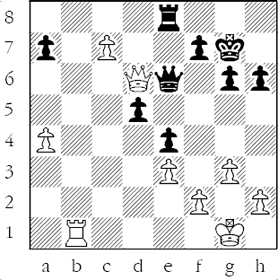
2-225 White to play and win

2-226 Black to play and win

2-227 White to play and win

2-228 White to play and win

2-229 White to play and win

2-230 White to play and win

2-231 White to play and win

2-232 Black to play and win

2-233 White to play and win

A safety check is done when you are considering a candidate move. You first check to see if the move loses material, before you decide whether it is good or not. So if you put a piece where it can be freely taken, or where it is attacked more than it is defended, or where it is subject to a double attack, then it is not safe and that candidate move must be eliminated.
2-223: 1.Bh6 Bc5 If 1...b3+ 2.Kb1 gxh6 3.g7 White wins. 2.Bxg7 Be7 3.Bh6 and White promotes, but not 3.Bh8? Bf8 4.g7? Bxg7 5.Bxg7 Kd4 6.Bxf6 Kxe4 7.Bxe5 Kxe5 8.Kb3 Kxf5 9.Kxb4=.
2-224: 1.Qxe6 fxe6 2.Rb8 and White promotes.
2-225: I first saw this well-known problem in Horowitz’s How to Win in the Middlegame. I included the first move for each side (1.Rc8+ Rxc8) to make it easier. 2.Qxa7+ Kxa7 3.bxc8N+ 2.bxc8Q+ Kxc8 3.Qc3+ fails because the bishop or queen can interpose the check and save the bishop.
2-226: 1...Qe1+ 2.Qf1 Qxd1 and Black promotes with mate after either 3.Qxd1 f1Q+ 4.Qxf1 Rxf1#; or 3.Rxf2 Qxf1+ 4.Rxf1 Rxf1#; 3.Rc1 Qxc1 4.Qxc1 f1Q+ 5.Qxf1 Rxf1#; and if 3.Ba6, then 3...Qxc2 wins easily. The immediate 1...f1Q+? fails to 2.Rxf1 Rxf1+ 3.Qxf1.
2-227: 1.Na5 Other moves also serve to block the a-file: 1.Na3; 1.Ba5; 1.Ba3. After this, White promotes to a queen, which is much better than just promoting immediately and letting the black rook capture the queen.
2-228: 1.Rh6+ Kf5 2.Ra6 Why win a rook, when you can get a whole queen and win easily? In fact, after 1.a8Q? Rxa8 2.Kxa8, according to the Shredder 6-piece tablebase, Black is winning!
2-229: The most famous promotion problem: 1.g6 hxg6 2.f6 gxf6 3.h6 wins or 1...fxg6 2.h6 gxh6 3.f6 wins. Note that the latter line with the f-pawn capture would not win if Black’s king were one file closer.
2-230: 1.Bxe6 fxe6 2.f7 This kind of double promotion threat is often possible against knights on the eighth rank.
2-231: 1.Ne6 Kf7 If 1...Bf6 2.Nxf4 Bg5 3.Nd5 wins easily. 2.Nxg5+ hxg5 and the two separated passed pawns win easily, e.g., 3.c4 g4 4.fxg4 Kf6 5.c5 Ke5 6.c6 Ke4 If 6...Kd6 7.h6 wins without a fight, so Black tries to counterattack with his center pawns. In this case it is not enough: 7.c7 f3+ 8.Kf1 f2 9.c8Q Kf3 If only Black had an extra tempo to play ...e2#! 10.Qf5+ and White wins easily.
2-232: 1...h3 2.Nxh3 e2 promotes. You can often sacrifice one pawn to promote another. It is a common theme that is good to know!
2-233: 1.f6! Interference. Other moves lose, e.g., 1.h5? Ke5 2.h6 Kf6 3.Kb2 Kf7 and Black wins the h-pawn with ...Kg8 and ...Kh7. 1...exf6 2.h5 f5 If 2...Ke5 3.h6 is the point, as Black cannot play ...Kf6 to stop the pawn. 3.h6 f4 4.h7 f3 5.h8Q+ wins easily.
Just because you can solve a tactical problem does not necessarily mean that you will spot the tactic in a game. The most important goal of studying tactics is to be able to spot the elementary motifs very quickly, so studying the most basic tactics over and over until you can recognize them almost instantly is likely the single best thing you can do when you begin studying chess!
Zugzwang means compulsion to move. It is a situation in which any move you make worsens your position. There are many endgame positions where the player who has the inferior position could draw if he did not have to move. The most common is the following: (D)
White plays 1.Kc6 and now, if Black did not have to move, then White could never win. But, of course, chess rules do not let one pass the obligation of moving, so Black must play 1...Ka7 and allow 2.Kc7 Ka6 3.b8Q Ka5 4.Qb3 Ka6 5.Qb6#.
White to play and win
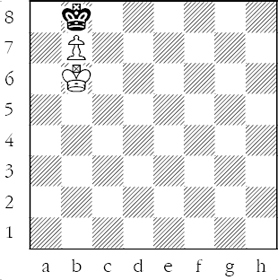
Again, White could not win the folling position if Black had the ability to pass instead of move.
White to play

But, since the requirement to move does exist, after the “slidey rook maneuver:” 1.Rc4 (or anywhere along the c-file except c8), Black is duly obligated to play 1...Ka8, allowing 2.Rc8#.
In the following position, it looks difficult for White to make progress until you realize he does not have to – he can just do nothing for one move.
White to play and win

1.Ra8 That keeps the status quo, as required! Black is compelled to abandon the bishop. 1...Ke8 2.Rxc8+ and White wins easily.
Zwischenzug
A zwischenzug is an in-between move. It means you stop the “normal” sequence to insert an even more forcing move to your benefit.
The Exchange Variation of the King’s Indian Defense provides us with an excellent practical example. Beginners often wonder why White cannot take Black’s e-pawn on move 8 or 9. But if he does, then Black’s knight becomes a desperado and will try to sell itself as dearly as possible:
1.d4 Nf6 2.c4 g6 3.Nc3 Bg7 4.e4 d6 5.Be2 0–0 6.Nf3 e5 7.dxe5 dxe5 8.Qxd8 Rxd8 9.Nxe5 Nxe4 Discovered attack on e5 so the white knight is a desperado, as is Black’s! 10.Nxf7 If White just takes the knight on e4, theory says that Black is OK, but what if he plays this move, taking a pawn and attacking the rook on d8?
Now if 10...Kxf7? 11.Nxe4 and White has gotten away with his pawn! But...
Black to play and win
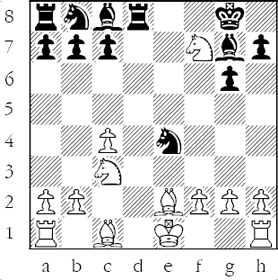
Black plays the zwischenzug 10...Bxc3+! 11.bxc3 and only now plays 11...Kxf7 winning a piece. So 6...e5 is tactically justified!
Zugzwang means compulsion to move. A zwischenzug is an “in-between” move.
Here is a very common zwischenzug example that makes use of a pin:
White to play and win

1.Re1! The rook is immune as 1...Qxe1+ is illegal because of the pin of the black queen to the king. Since White is threatening 2.Rxe5 and Black’s queen cannot move off the diagonal, 1...Qxf4 is forced (1...Qc7 2.Rxe8#), but then the zwischenzug 2.Rxe8+ Kc7 3.gxf4 allows White to win a rook.
Perpetual Check
There is no draw rule because of “perpetual check,” but there is a rule that the game is drawn because of “threefold repetition of position.” So any perpetual check will finish as a draw under this rule. Therefore, the concept of perpetual check is quite sound. Here is a cute example.
White to play and draw

Down a queen, White looks to be in a lot of trouble, but is saved by the cute 1.Qd8+ and no matter how Black interposes, White can continue to check on d8, d5, and a5, e.g., 1...Qbb8 2.Qd5+ Qab7 3.Qa5+ Q8a7 4.Qd8+ with a draw by “perpetual check”!
2-237 White to play and draw

2-238 Black to play and draw
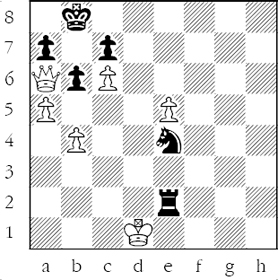
2-239 Black to play and draw

2-234 White to play and win
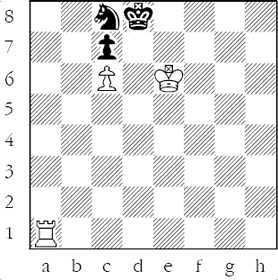
2-235 White to play and win

2-236 White to play and win

2-240 White to play and draw

2-241 White to play and win a pawn

2-242 White to play and win

2-243 White to play and win

2-244 Black to play and draw

2-245 White to play and win

When both kings are exposed and the heavy pieces are still on the board, the initiative (or attack) is often worth everything – so you usually should keep checking (or capturing) if you can. In such positions, sacrifices of material are often quite common, as you cannot let your opponent start attacking with tempo.
2-246 Black to play and win

2-234: 1.Ra8 Black is in zugzwang. 1...Ke8 2.Rxc8#
2-235: 1.Ke6 Kb6 2.Kxd6 Kb7 3.Ke7.
2-236: 1.Ke7 Kc5 2.Ke6 Zugzwang. 2...Kc4 3.Kxd6.
2-237: 1.Qb8+ Ke7 2.Qe5+ Kf8 2...Kd8 3.Qb8+ repeats the position. 3.Qh8+ Ke7 4.Qe5+ with a repetition of position. 1.Qf8+? does not work: 1...Kc7 2.Qc5+?? Qxc5.
2-238: 1...Nc3+ 2.Kc1 Na2+ 3.Kb1 Nc3+ 4.Kc1 is a draw by threefold repetition of position. 4.Ka1?? allows Ra2#.
2-239: 1...Qxg2+ 2.Rxg2 Rxg2+ 3.Kh1 Rxg1+ draw (stalemate or perpetual).
2-240: 1.Rg3+ Kh8 2.Bg7+ Kg8=.
2-241: 1.Nd5 Qxd2 (1...Qd8 2.h4 and White has a big advantage.) 2.Nxe7+ A common zwischenzug. 2...Kh8 3.Rxd2.
2-242: 1.Qxe6+ An easy zwischenzug. 1...Kg7 32.Rxf2.
2-243: 1.Nxe7+ Kf8 2.Nxg6+ wins the exchange.
2-244: 1...Rc4+ 2.Qxc4 stalemate.
2-245: 1.Nxh6+ Kh8 1...gxh6 2.Rg1#. 2.Qd5 wins a piece, e.g., 2...Ne7 3.Nxf7+ Kg8 4.Nh6+ Kh8 5.Qe6. But not 5.Qg8+??, when 5...Nxg8 wins for Black (and not 5...Rxg8?? 6.Nf7#).
2-246: 1...Qc1+ Another easy zwischenzug, allowing Black to win the bishop. 2.Kg2 Rxc8.
You should not make a threat with the expectation that your opponent might not see it. You should assume he will see it, and be willing to accept what happens anyway.